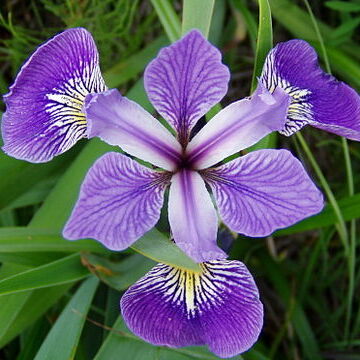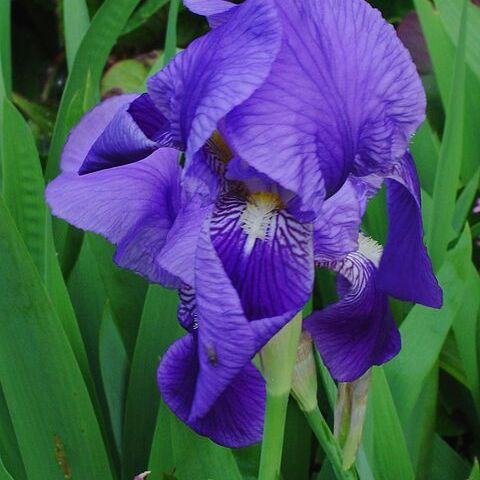Herbs perennial, usually with short or long rhizomes (or bulbs), sometimes with swollen storage roots. Leaves mostly basal, 2-ranked, often oriented edgewise to aerial stem, sword-shaped to linear. Aerial stem developed, much shorter than or longer than leaves. Inflorescence of rhipidia arranged in racemes, panicles, or solitary. Flowers white, yellow, blue, violet, or purple, relatively large, often fragrant. Perianth tube usually trumpet-shaped, sometimes very narrowly so, very short to long; outer 3 perianth segments (falls) ornamented or not, with a crested, bearded, or beardless claw (haft), and an expanded, usually reflexed limb (blade), the beard or crest (when present) extending along midvein of proximal part of limb adaxially; inner 3 perianth segments (standards) smaller, never ornamented, erect or spreading. Stamens opposed to style branches and appressed to them; filaments free, flattened. Style with 3 colored, expanded, petaloid branches, arching over stamens, apex of branches extended as 2 lobes (crests) projecting beyond flaplike, abaxial stigma. Capsule globose, ellipsoid, or cylindric, apex beaked or not. Seeds pyriform, flattened and D-shaped, or irregularly angled, sometimes arillate.
Evergreen perennial, with rhizomes (sympodial), or bulbous. Leaves equitant, ensiform, distichous. Cyme shortly branched, few-flowered. Flowers pedicellate, large and showy, blue, violet, white or yellow, in clusters of 2 or more, (or solitary), terminal flowers within 2 spathe-valves, lateral within a single valve; tube bright green, usually short; segments (each consisting of broader "limb" and narrow basal "claw" or "haft") in 2 whorls; 3 outer (falls), usually reflexed or spreading, 3 inner (standards), usually erect and often incurved, or spreading. Stamens 3, inserted at base of outer segments. Style-branches broad, petaloid, ± deeply bifid at tip, curved over stamens and concealing them, stigma a small flap situated on underside of petaloid style-branch just below bifid "crest". Capsule coriaceous, ovoid-oblong. Seeds many, globular, ± compressed. Spp. c. 300, from temperate regions of N. Hemisphere. Adventive spp. 5.
Perennials, evergreen and rhizomatous or (not in Australia) bulbous with annual leaves and flowers. Leaves mostly basal, equitant, usually erect and ensiform. Scape erect, simple or few-branched, rarely absent. Spathes herbaceous, sheathing rhipidia of few flowers separated by shorter bracts or rarely sheathing a flower. Sepals and petals clawed, united in a tube. Sepals spreading or deflexed. Petals erect, often smaller. Stamens free, inserted on tube; anthers basifixed, linear. Ovary ovoid-trigonous; style deeply trifid; branches broad, petaloid, arched over sepals and appressed to stamens. Stigmas transverse, exceeded by prominent bifid crests. Capsule ovoid to clavate, trigonous, exserted from spathes.
Sep spreading or reflexed; pet erect or arching, in our spp. narrower and shorter than the petaloid sep; tep all united below into a perianth-tube; stamens inserted at the base of the sep; ovary 3-or 6-angled or-lobed; style divided distally into 3 petaloid branches arching over the stamens, each 2-lobed at the tip; stigma a thin plate or lip at the outer base of the 2 lobes; fr coriaceous or chartaceous, loculicidal or indehiscent; seeds in 1 or 2 rows per locule; perennial herbs with ensiform or linear lvs, our spp. with horizontal rhizomes and usually erect fl-stalks bearing 1–many fls. 200, N. Temp. Much hybridized in cult.


